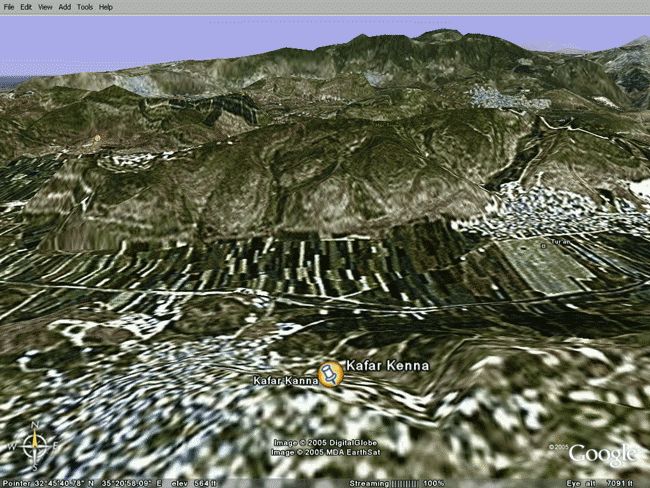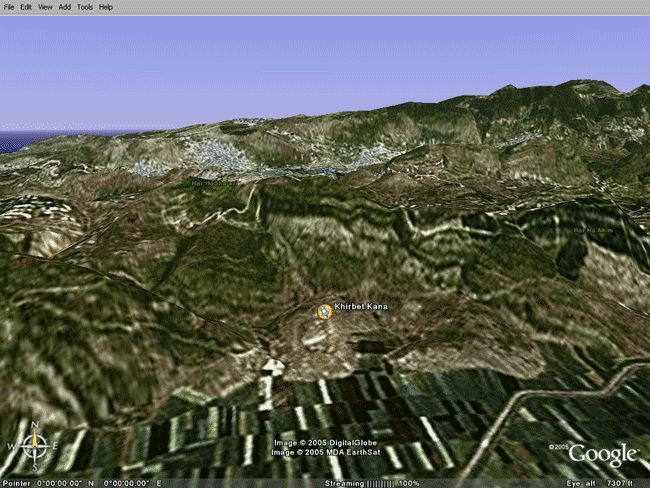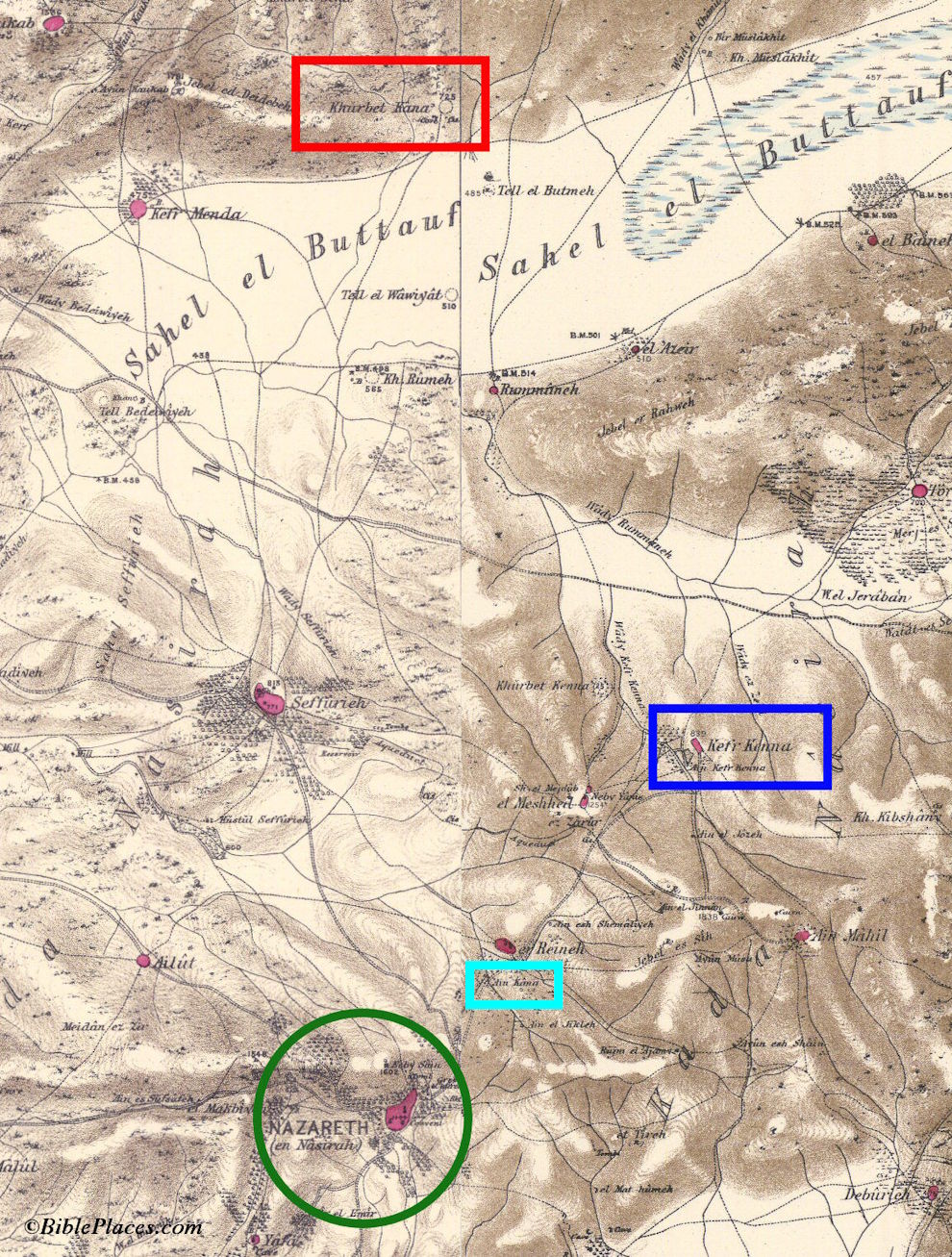© 2009 Jan Herca (license Creative Commons Attribution-ShareAlike 4.0)
Although it may seem strange, there are still many biblical sites whose exact location is unknown. Sometimes the location has not been discovered, but in other cases there are a multitude of hypotheses that make it difficult to decide on a location. This is the case of Cana of Galilee, the ancient city where, according to the Gospel of John, Jesus performed his first miracle, turning water into wine.
Many authors and scholars of the life of Jesus assume only one location for Cana, but the reality is that there is no unanimity among archaeologists and experts about the correct location.
Let us examine the four possible deposits under consideration:
¶ Kanah
Location:
Located about thirteen kilometers southeast of ancient Tyre, there is currently a town called Qana.
Arguments in favor:
It is mentioned by Eusebius (Onomástica Sacra 110, 3-6; 271, 50-53), and Jerome (Latin translation of the Onomasticon). Jerome also notes that there were two cities called Cana, one of them called “the great.”
Arguments against:
This Cana would be located in Phoenicia at the time of Jesus, not Galilee, and would be a very unlikely place for a Jewish wedding and for Jesus to begin his ministry there. Also, it would not make much sense for Nathanael and Philip, the apostles, to be friends, Philip being from Bethsaida (by the Sea of Galilee), as we are told in John 1.
¶ 'Ain Kanah
Location:
Located about two kilometers northwest of Nazareth, where there is a fountain with this name on a road that leads from Reinah to Mount Tabor.
Arguments in favor:
This site was suggested by CR Condor in 1878 because the present name of 'Ain Kanah suggested a Greek translation of an ancient settlement called Cana.
Arguments against:
There is no evidence from tradition or archaeology. No ruins have been found.
¶ Kefar Kenna
Location:
Located six kilometers northeast of Nazareth.
Arguments in favor:
It is the place that tradition has marked as the correct place, there being a Franciscan church on some ruins of deposits that are claimed as the vessels that contained the wine of the miracle.
On the other hand, according to D. Zeller (1869), it was situated in an ideal position. Today there are only about 200 houses in the place, but he calculated that it must have been a town three times larger in the past, if we take into account the existence of a good fountain nearby and its location on a west-facing slope.
Zeller also claims that the Cana mentioned by Josephus in his biography can only refer to this place, although the arguments he offers can also be applied to Khirbet Kana. Josephus narrated that they made a night march with Jewish soldiers from Cana to Tiberias. This march, some 18 kilometers, could just as well have been made from Kefar Kenna as from Khirbet Kana.
Finally, the final argument in favor of Kefar Kenna is tradition. But it is a common mistake to consider that the tradition about this place goes back to the time of Jesus. Only in the 17th century did this place begin to be considered the most probable, although others, such as Kanah and Khirbet Kanah, were already known. Finally, the Franciscans acquired a piece of land on which they built a church.
Arguments against:
No archaeological remains have been found that can be traced back to the time of Jesus, although ruins from that period have been found at a site several kilometres away.

¶ Khirbet Kanah
Location:
Located about twelve kilometers north of Nazareth, these are uninhabited ruins located on the slopes that border the Bet Netufa valley to the north, also known as the Battauf plain.
Arguments in favor:
This site was situated in a strategic position, on an ancient road that probably connected ancient Ptolemais with Magdala, and on the route that connected Nazareth with Jotapata, an ancient stronghold of Jewish resistance. This makes it seem more acceptable in the light of the accounts of Flavius Josephus. There is a mention by Josephus even linking Cana in Galilee with the plain of Asochis, which can be identified with the valley of Bet Netufa.
On the other hand, the great archaeologist Robinson was the first to point out that the Arabic name of the place (Kana el-Jelil) is a faithful translation of the Greek equivalent of Cana of Galilee.
Archaeological evidence has also been found at this site, indicating that it was inhabited during the Israelite, Roman and Arab periods.

Arguments against:
There do not seem to have been any water sources in this area. But how could it be that a population was established here? There is a logical explanation. Numerous cisterns were dug to collect rainwater, just as was done in many other places in these lands.
Another argument against the idea is that we are told in the gospels that Jesus traveled along the route Nazareth - Cana - Capernaum, and Khirbet Kanah is not on the shortest route linking these towns.
Another argument against it is the small size of the site, which has been estimated to have contained no more than 50 houses, although these estimates are based on a few excavated ruins.
Finally, some scholars raise objections when considering the testimonies of several medieval pilgrims who speak of a church being built in Cana by Constantine’s mother, Helena.
¶ A news item in the media
A few months ago, a news item appeared in the media, about which I have not been able to obtain much information, announcing that a new discovery had been made in Kefar Kenna. In the references you will find links to some websites with the news item.
The discovery is related to excavations that have been carried out since 1999 near Kefar Cana, which is now commonly called “modern Cana” (because it is the only site, other than Phoenician Cana, that is currently inhabited).
However, it is somewhat surprising how little caution the archaeologists of this excavation have shown in their findings, claiming, simply because they found remains of stone vessels, that they had found the house where the wedding took place. Let us remember that the Gospel of John mentions very precisely that “at the wedding there were six stone jars, each holding about 80 to 100 litres” (Jn 2:6). Apparently the archaeologists have unearthed remains of vessels of these dimensions.
But does this mean that we have discovered the house in question? These vessels, as many other excavations have shown, were very common furniture in Jesus’ time. Much more study and careful excavation will be necessary to reach any conclusion about these new findings, but what is clear is that they provide an interesting added incentive to the controversy over the true location of Cana.
¶ What does The Urantia Book say?
The Urantia Book makes several mentions of Cana, but none of them provide a clear indication of the location of the site. We can only note that Jesus travels from Capernaum to Cana with part of his family in a single day. However, this does not tell us much. Virtually all of the sites were within a day’s drive of Capernaum, although the one that is especially close is Khirbet Kana (see UB 137:3).
So which one should you choose?

¶ Conclusions
In my opinion, and following the experts, the first two sites, Kana and 'Ain Kanah, do not have a solid basis to justify their choice. We are therefore left with two options: Kefar Kenna and Khirbet Kana.
Although many experts easily suggest the choice of Kefar Kenna, after having examined the testimonies, comparing plans and geographical references, and having accessed the web pages where the progress of the archaeological campaigns in both sites are shown, I personally lean towards Khirbet Kana, and this is reflected in Jesus of Nazareth[1].
It should be noted that Kefar Kenna was situated at the time of Jesus on the road that linked Sepphoris to Tiberias. However, we know that Tiberias began to be built during the youth of Jesus, and that Sepphoris underwent a major urban remodelling at that time as well. All this was due to the building spirit of Herod Antipas, who chose first Sepphoris and then Tiberias as the capitals of his kingdom.
It is therefore logical to think that a Roman road was built between the two towns, which would continue westwards, linking the Sea of Galilee with the Mediterranean. But this road would have been under construction at the time of Jesus, or only recently built. On the other hand, the passers-by on this road would undoubtedly have been inhabitants of these two towns, mostly Jews with relaxed customs and pagans. It is easy to imagine that this road would not have been a common route for Jews at the time.
We also know that there was another road parallel to this one long before, a typical Jewish road that linked Ptolemais with Capernaum and that ran through a pleasant valley. This makes it easier for me to imagine the Jews travelling along this route and avoiding the pagan road that linked Sepphoris with Tiberias. It is natural to think that the ancient Cana of Galilee was located on this typical Jewish road.
From all this, together with the fact that remains from the time of Jesus have certainly been found in Khirbet Kana and have not been found so clearly in Kefar Kenna, my idea of opting for Khirbet Kana as the place where the famous wedding took place has arisen.
But once it has been decided that Kefar Kenna is not the correct location, another question arises: what population existed near Nazareth in the time of Jesus? Obviously, further research will have to be carried out…
¶ References
-
A very good article that sums up the whole issue.
-
General information from a tourist agency.
-
Here you can see an interactive 3D flight of Khirbet Cana.
-
The new archaeological find at Kefar Kana.
-
A fairly good map of the location of the two sites. (The link is broken, but the map is provided above.)
¶ External links
¶ Notes
This book is the novel «Jesus of Nazareth», a biography of the Master based on The Urantia Book that is in preparation by the author. ↩︎